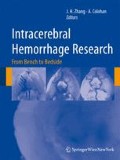Abstract
Objects: Neurogenic pulmonary edema (NPE) is a well-known complication of subarachnoid hemorrhage (SAH), which potentially causes a poor outcome. The aim of this study was to examine if NPE occurs in the endovascular perforation model of SAH in mice and if apoptosis contributes to NPE development after SAH in mice.
Methods: Sham-operated or SAH mice were treated with an intraperitoneal administration of vehicle or an antiapoptotic drug Z-Val-Ala-Asp-fluoromethylketone (Z-VAD-FMK) 1 h post-SAH. Pulmonary edema measurements and evaluation of apoptosis occurrence were performed on the lung at 24 h post-SAH.
Results: SAH caused NPE, which was associated with apoptosis of pulmonary endothelial cells. Z-VAD-FMK significantly prevented apoptosis and NPE.
Conclusions: Pulmonary endothelial cell apoptosis contributes to the pathophysiology of NPE after SAH in mice.
Access this chapter
Tax calculation will be finalised at checkout
Purchases are for personal use only
References
Baumann A, Audibert G, Mcdonnel J, Mertes PM (2007) Neurogenic pulmonary edema. Acta Anaesthesiol Scand 51:447–455
Sozen T, Tsuchiyama R, Hasegawa Y, Suzuki H, Jadhav V, Nishizawa S, Zhang JH (2009) Role of interleukin-1β in early brain injury after subarachnoid hemorrhage in mice. Stroke 40:2519–2525
Steinberg J, Halter J, Schiller H, Gatto L, Carney D, Lee HM, Golub L, Nieman G (2005) Chemically modified tetracycline prevents the development of septic shock and acute respiratory distress syndrome in a clinically applicable porcine model. Shock 24:348–356
Hasegawa Y, Suzuki H, Sozen T, Rolland W, Zhang JH (2010) Activation of sphingosine 1-phosphate receptor-1 by FTY720 is neuroprotective after ischemic stroke in rats. Stroke 41:368–374
Raßler B, Reißig C, Briest W, Tannapfel A, Zimmer HG (2003) Pulmonary edema and pleural effusion in norepinephrine-stimulated rats: hemodynamic or inflammatory effect? Mol Cell Biochem 250:55–63
Sedy J, Zicha J, Kunes J, Jendelova P, Sykova E (2008) Mechanisms of neurogenic pulmonary edema development. Physiol Res 57:499–506
Uhal BD, Rayford H, Zhuang J, Li X, Laukka J, Soledad-Conrad V (2003) Apoptosis-dependent acute lung injury and repair after intratracheal instillation of noradrenaline in rats. Exp Physiol 88:269–275
Suzuki H, Sozen T, Hasegawa Y, Chen W, Zhang JH (2009) Caspase-1 inhibitor prevents neurogenic pulmonary edema after subarachnoid hemorrhage in mice. Stroke 40:3872–3875
Zhang XH, Zhu RM, Xu WA, Wan HJ, Lu H (2007) Therapeutic effects of caspase-1 inhibitors on acute lung injury in experimental severe acute pancreatitis. World J Gastroenterol 13:623–627
Zhang Y, Rosenberg PA (2004) Caspase-1 and poly (ADP-ribose) polymerase inhibitors may protect against peroxynitrite-induced neurotoxicity independent of their enzyme inhibitor activity. Eur J Neurosci 20:1727–1736
Fontes RBV, Aguiar PH, Zanetti MV, Andrade F, Mandel M, Teixeira MJ (2003) Acute neurogenic pulmonary edema: case reports and literature review. J Neurosurg Anesthesiol 15:144–150
Acknowledgement
This study is partially supported by NIH NS053407 to J.H. Zhang. Conflict of interest statement We declare that we have no conflict of interest.
Author information
Authors and Affiliations
Corresponding author
Editor information
Editors and Affiliations
Rights and permissions
Copyright information
© 2011 Springer-Verlag/Wien
About this chapter
Cite this chapter
Suzuki, H. et al. (2011). Subarachnoid Hemorrhage Causes Pulmonary Endothelial Cell Apoptosis and Neurogenic Pulmonary Edema in Mice. In: Zhang, J., Colohan, A. (eds) Intracerebral Hemorrhage Research. Acta Neurochirurgica Supplementum, vol 111. Springer, Vienna. https://doi.org/10.1007/978-3-7091-0693-8_21
Download citation
DOI: https://doi.org/10.1007/978-3-7091-0693-8_21
Published:
Publisher Name: Springer, Vienna
Print ISBN: 978-3-7091-0692-1
Online ISBN: 978-3-7091-0693-8
eBook Packages: MedicineMedicine (R0)

